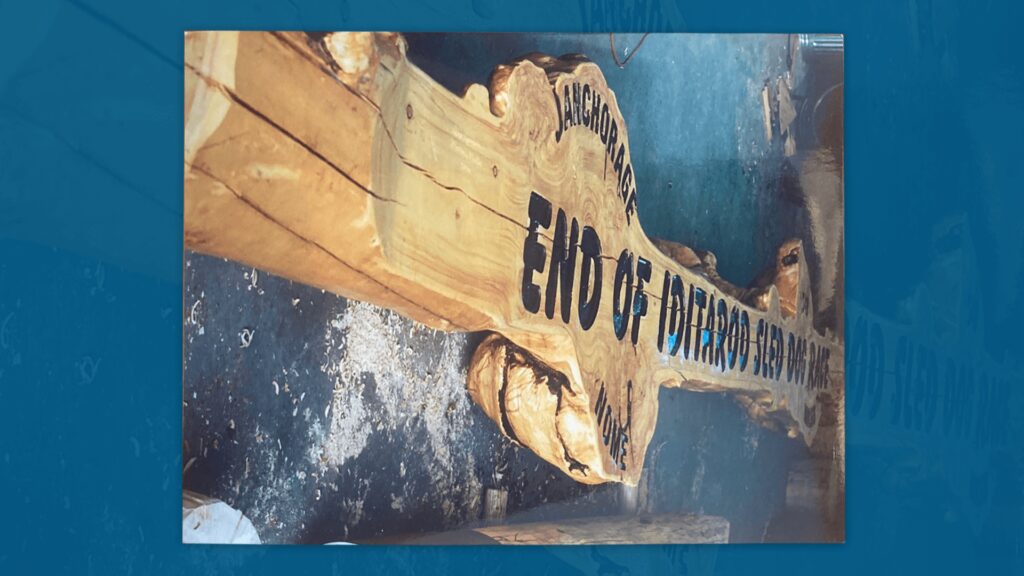As mushers wrapped up their stories of the trail at the finishers’ banquet, one last team was welcomed on Front Street in Nome at 9:20 p.m. After two prior attempts, this year’s Red Lantern, Cindy Abbott, completed her first Iditarod. KNOM’s Jenn Ruckel has the story.
“Three, two, one… Welcome to Nome!” the crowd cheered.
The final canine athletes of Iditarod 43 excitedly tangled themselves just feet from the chute, accompanied by a local puppy who wanted to get in on the action.
“I’ve never seen a loose dog in the chute in all the years I’ve been here,” said one race official.
But despite the challenges, Red Lantern Cindy Abbott finally crossed under the burled arch—the first woman (and only the second person) to summit Mt. Everest and complete the 1,000-mile sled dog race.
It’s a goal she’s had for several years. She entered the Iditarod in 2013 and 2014, but had to scratch both years for the safety of her team due to personal injury.
“It’s been a long race and it’s been long years getting here, seeing as how this is my third try.”
I asked Cindy at what point she knew that she was going to make it all the way to Nome.
“When I started!” she responded.
“So, we’re gonna write in [on the NORD banner] now: Everest 2010, Iditarod 2015. There we have it. My NORD Rare Disease Awareness banner. That’s pretty cool.”

Abbott, who lives with her husband and daughter in Irvine, California, teaches health science at California State University, Fullerton. Abbott is an advocate for the National Organization of Rare Disorders (NORD). While training for Everest, she was diagnosed with Wegener’s Granulomatosis, a form of vasculitis. But Abbott, who is now blind in one eye, decided she wasn’t giving up, because she had a mountain to climb.
“For 14 years I went undiagnosed with a very rare disease and then I was finally diagnosed. So to help raise awareness I took this banner to the top of Mt. Everest and became the 40th American female to summit Mt. Everest in 2010,” said Abbott. “And then after that they said, ‘What are you gonna do next? Run the Alaskan Iditarod?’ And I said, ‘Yeah, that actually sounds like an awesome thing to do!’”
After 54 days on the mountain—Abbott reached the top of Everest with her NORD banner. And now, she has stood with it under the burled arch.
“Not too many people or things have been through both,” said Abbott. “Everest took two months living on a mountain, and this took two weeks or a little short of it, but for me this was harder by far. Mostly because I had to not just worry about myself. I had to worry about all those dogs. So this is pretty amazing.”

Abbott began mushing in 2011 with Lance Mackey’s Comeback Kennel. During her first attempt, she injured her leg but traversed 600 miles before scratching, when medical examination revealed her pelvis was broken in two places.
Sunday night, with a strong team of 13 dogs, Abbott exchanged the symbolic red lantern for a daring climb up the burled arch to extinguish the widow’s lamp—officially signifying the end of the Last Great Race for 2015. It was the only challenge more terrifying than 1,000 miles of Alaskan wilderness.
“This is not safe,” said Abbott, laughing as she climbed on a man’s leg to reach the glowing lamp. “This is scary up here!”
Abbott finished with a total elapsed time of 13 days, 11 hours 19 minutes and 51 seconds.
“Cindy, thank you for closing out Iditarod 43. Good job!” said one race official.
Abbott will be honored at her own Red Lantern banquet at the Mini Convention Center in Nome at 6 o’clock tonight. Reporting under the burled arch in Nome, I’m Jenn Ruckel.







